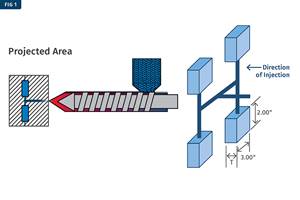Study Finds Jam Bars Redundant: U.S. and European IM Suppliers Move Closer Towards Harmonization
Ruled redundant, could jam bars be going the way of plungers on new injection molding machines sold into the U.S.?
On March 30, SPI’s Equipment Council released an official injection molding machine risk assessment and report commissioned in 2014, which ultimately could represent the first step in eliminating the mechanical safety devices from horizontal presses.
Completed by Bruce Main of design safety engineering inc., Ann Arbor, Mich., the risk assessment is an important advance in what has been 15-year-plus effort to harmonize injection molding machine safety standards between North America and Europe.
One particular sticking point in these harmonization efforts has been the North American market’s requirement that injection molding machines feature both a mechanical safety device, often called the drop or jam bar, as well as electrical means to ensure that when a machine gate is open the platens cannot close.
In Europe, under safety standard EN 201, the so-called jam bar is not required, while in North America, it has been mandatory under ANSI SPI 151.1, according to Stan Glover, director of sales at machine component supplier, Zeiger Industries, Canton, Ohio. Glover is also the chair of SPI’s Machinery Safety Standards Committee.
What Happens Next
SPI leadership and machinery suppliers were consistent in their praise of the decision but all noted that further discussions are necessary before big changes are made in how machines can be set up in the U.S.
“Essentially, the equipment council funded this study to take a look at the relative safety of the device,” Glover said, “and now that the report is complete, it’s up to each manufacturer of machinery to do as they see fit.”
David Preusse, president of auxiliary equipment, robot and injection molding machine supplier Wittmann Battenfeld Inc., Torrington, Conn., said his company, which is headquartered in Vienna, was “delighted” that SPI had examined the matter and found the jam bar redundant. In the immediate aftermath of the decision, Preusse, and numerous other machinery suppliers, were adopting a wait-and-see stance.
“While ultimately the adoption or change to remove the jam bar is made by each supplier, I am certain more meetings and documentation will be required by manufacturers to develop their own game plan,” Preusse said. “In time, it may become an option for U.S. customers to buy the jam bar if they insist. As we know, Europe, Mexico and many other parts of the world have removed the jam bar and some may argue it can be dangerous to leave it on, while it’s redundant.”
David Palmer, director of industry affairs for SPI’s Equipment Council, acknowledged that there will be more discussions about the issue going forward. “We need to work with regulatory agencies at the state and federal levels across the country to ensure that they all understand the findings of the risk assessment and that their regulations governing workplace safety and the use of plastics machinery are up to date and in agreement with the conclusions and recommendations of the report,” Palmer said. “
In addition, Palmer said SPI would work with its member companies on the matter to “ensure that they understand what the risk assessment means and what actions they can take accordingly to design, build, sell, and use better and safer machinery to enhance their business operations and maintain the highest quality of their products.”
Those immediate discussions will also include the Occupational Safety and Health Administration (OSHA) at the federal and state level, including Michigan, which had its own measure on the safety device.
“While I’m sitting here, another email came in from another machinery manufacturer,” Glover said, noting that at that time 14 machinery manufacturers had already reached out to see what the next steps are.
“Machinery council members and members of SPI’s leadership need to sit down and review how to move forward,” Glover said.
Related Content
Got Streaks or Black Specs? Here’s How to Find and Fix Them
Determining the source of streaking or contamination in your molded parts is a critical step in perfecting your purging procedures ultimately saving you time and money.
Read MoreThree Key Decisions for an Optimal Ejection System
When determining the best ejection option for a tool, molders must consider the ejector’s surface area, location and style.
Read MoreA Systematic Approach to Process Development
The path to a no-baby-sitting injection molding process is paved with data and can be found by following certain steps.
Read MoreIs There a More Accurate Means to Calculate Tonnage?
Molders have long used the projected area of the parts and runner to guesstimate how much tonnage is required to mold a part without flash, but there’s a more precise methodology.
Read MoreRead Next
See Recyclers Close the Loop on Trade Show Production Scrap at NPE2024
A collaboration between show organizer PLASTICS, recycler CPR and size reduction experts WEIMA and Conair recovered and recycled all production scrap at NPE2024.
Read MorePeople 4.0 – How to Get Buy-In from Your Staff for Industry 4.0 Systems
Implementing a production monitoring system as the foundation of a ‘smart factory’ is about integrating people with new technology as much as it is about integrating machines and computers. Here are tips from a company that has gone through the process.
Read More




















